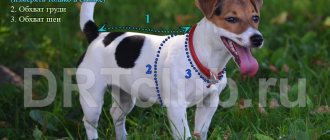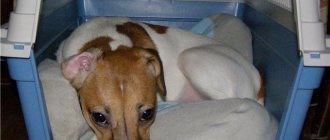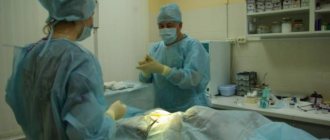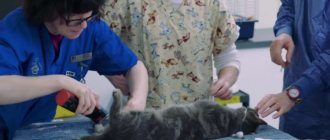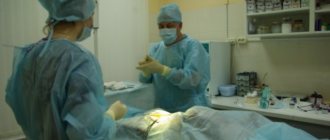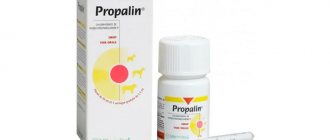Sterilization or castration
Many people confuse two essentially different operations. Castration is the removal of a male dog's testicles or a female dog's ovaries. Animals become infertile, their secretion of hormones stops, dogs calm down, do not attract male dogs on walks, and do not dirty furniture and sofas in the apartment.
Sterilization is a way of preserving sexual instincts without the possibility of fertilization. It has no practical meaning, because all signs of sexual behavior remain, except conception. However, in Russia it is customary to call the surgical removal of the genitals of a male castration, and sterilization of a female.
Differences between spaying and neutering in dogs
It is generally accepted in society that only males are castrated and only females are sterilized. The real picture is completely different; both types of surgery are used for dogs of both sexes.
Sterilization is a simpler operation, after which a dog of any sex has no reproductive function. At the same time, all organs of the genitourinary system remain in place, the production of testosterone (in males) and estrogen (in females) continues. During the operation, the fallopian tubes are ligated for females, and the seminal ducts for males. If the owner wishes, the consequences of sterilization are reversible - it is permissible to perform a second operation and completely restore the dog’s ability to reproduce.
Castration is a more complex procedure, after which the animals also completely lack reproductive function. It differs from sterilization in that during castration, the genitals are removed (in whole or in part), the process is irreversible. After castration, testosterone and estrogen are practically not produced, due to which sexual desire and the need for mating completely disappear. During the operation, the testes and part of the seminiferous tubules are removed for male dogs, and the ovaries for females (with complete castration along with the uterus, appendages and fallopian tubes).
Why is castration needed?
Sterilization is necessary only in order to avoid having unwanted offspring from animals that do not represent breeding value. Absolutely all body functions, including sexual desire in males and estrus in females, are preserved.
Castration completely eliminates behavioral problems associated with sexual desire:
- Intraspecific aggression;
- Sexual markings (territorial ones remain);
- Tendency to escape;
- “Dog weddings” for a bitch in heat.
In addition to behavioral problems, just like with sterilization, there are no offspring after castration. Moreover, there are a number of medical indicators for performing surgery to remove the genital organs, including the prevention of neoplasms, pyometra, endometritis, and prostatitis.
Age of sterilization
Castration too early can lead to developmental disorders, so the optimal period for spay removal is considered to be 6–18 months. It depends on the characteristics of the breed and the weight of the bitch. It is advisable that the female be operated on several weeks before the onset of her first estrus. To calculate the correct time for sterilization, the results of blood tests for estrogens will help. Veterinarians strongly recommend spaying all female dogs over 8 weeks of age to prevent mammary gland cancer.
Cancerous degeneration of the mammary glands
When to spay a dog?
Does it matter at what age a dog has surgery? Definitely yes! And the younger the animal, the better. When can a dog be spayed? Dog handlers say that bitches who have passed their first heat are suitable for the procedure. As a rule, these are 6-8 month old pets. This is the most optimal age for sterilizing dogs. But surgery is contraindicated for puppies - it can lead to disturbances in the animal’s body. Veterinarians refuse to sterilize adult dogs that are more than 8 years old. At this age, the risk of developing side effects (especially urinary incontinence) increases significantly.
Can a dog be spayed while in heat? This is not the best period for surgery. During estrus, hormonal surges occur in the animal's body, pets are too excitable. Therefore, during the operation, a huge dose of anesthesia may be required. Sterilization performed during estrus can also affect the postoperative condition of the dog - it will take longer and more painfully to recover from the procedure.
Advantages and disadvantages
The positive aspects of sterilization include the following:
- The dog's behavior becomes calm.
- There is no need to put on panties or wash damaged carpets and sofas.
- Males do not bother you while walking, and there is no need to be afraid of unplanned matings.
- The absence of intercourse prevents contracting genital infections.
- There is no danger of false pregnancy.
- The likelihood of developing tumors of the lactation gland is reduced.
- The female dog is easier to train.
- The dog's qualities as a guard improve.
- Spayed females behave more attentively when hunting.
- Females do not run away from home and do not participate in dog weddings.
During heat, the bitch wears panties.
The negative consequences of sterilization include the risks of ailments:
- osteosarcomas;
- hemangiosarcomas (cancer of the walls of blood vessels) – the beds of myocardial and splenic bloodstreams are affected;
- obesity and associated diabetes mellitus;
- urinary incontinence;
- hypothyroidism.
Sterilization methods
Sterilization of a female dog is an abdominal operation performed under general anesthesia. There are the following ways to carry it out:
- Dissection along the white stripe of the abdomen.
- Side cut.
- Laparoscopy.
- Chemical methods.
Dissection along the white stripe of the abdomen
The classic method, which is possible in the clinic and at home. If sterilization is carried out before the first heat, the ovaries are removed. Removing the uterus at this age is dangerous due to the risk of the ailments mentioned above. If a female dog who has given birth is spayed, veterinarians recommend cutting off both the ovarium and the urethra, that is, performing an ovariohysterectomy. The absence of ovaries does not protect the dog from pyometra, metritis and other ailments, so emergency re-sterilization is not excluded.
White line incision
Side cut
The method was developed for sterilizing stray dogs. Bitches who have recovered from anesthesia are released outside. The method is low-traumatic, but does not make it possible to assess the condition of other organs, so surgeons prefer an incision along the white stripe.
Laparoscopy
This advanced method requires complex, expensive equipment and trained personnel, which not all veterinary hospitals have. Laparoscopy is one of the most expensive methods of castration of dogs.
Laparoscopy
Chemical methods
Sterilization of a female without surgery is possible through regular injections of a hormonal drug or by introducing a Suprelorin implant under the skin. These methods lead to temporary loss of sexual function. To maintain the infertility of the bitch, constant injections are necessary. The use of hormonal drugs is fraught with numerous complications, so most Russian veterinarians do not recommend their use.
How is the operation performed?
Ovariohysterectomy in dogs is performed under general anesthesia. The animal is given an injection, after which it falls asleep. The veterinary surgeon fixes the dog on the table, treats the surface with alcohol and makes a small incision. The doctor finds the uterus and ovaries in the dog's abdomen and then removes them. The veterinarian applies a triple suture to the wound.
The edges are treated with iodine or another antiseptic. A sterile napkin is applied to the seam. Afterwards, a blanket is put on for the dog after surgery.
In some clinics, the furry patient is observed until he fully recovers from anesthesia, while in others, immediately after surgery, he is given to the owner. The doctor may invite the owner to come to the clinic the next day to examine the animal. Sometimes a course of antibiotics is prescribed after surgery.
Preparation
Dogs are sterilized during anestrus to prevent large-scale hemorrhage. Experts recommend conducting an examination to determine the appropriate method of anesthesia. It includes:
- Anamnesis. The dog owner informs the veterinary surgeon about past diseases, allergic reactions, timing of deworming, and vaccination.
- Laboratory blood tests.
- Instrumental studies - ultrasound. Particular attention is paid to the condition of the dog's heart.
- Expulsion of fleas.
- Starvation diet. Anesthesia causes vomiting, so to keep the dog's stomach empty, it is not fed. Some surgeons recommend emptying the intestines as well. To do this, the dog is given Vaseline oil a day before surgery. It is not absorbed and does not overload the liver, unlike plant-based ones. Dogs are not given water 4 hours before sterilization.
- Before anesthesia, premedication is given - drugs are administered to support breathing and myocardial function.
- For anesthesia, intramuscular injection of Xylazine and intravenous Propofol are used. For mask or endotracheal inhalation anesthesia, mixtures of gases are used.
For each type of anesthesia, there are indications and limitations that are taken into account by the veterinary anesthesiologist.
Inhalation anesthesia
(The operation is carried out in a clinic and also at home)
Prevention:
Regular whelping.
The keeping and breeding of dogs (bitches) must be organized in such a way that there are no long breaks between subsequent production of offspring. Avoid the use of hormonal drugs to terminate pregnancy, as well as to regulate or suppress the sexual cycle. Maintaining the hygiene of the female external genitalia during the estrous period (estrus). Prevention and timely treatment of vaginitis (inflammation of the vagina) and acute postpartum metritis, as well as infectious and other diseases affecting the reproductive system of dogs. Timely castration (sterilization) of the dog
.
If further breeding is not planned, we recommend surgery to remove the ovaries and uterus. You can check prices, learn about details and consult on upcoming treatments and procedures by contacting us by phone on the contacts page
Carrying out the operation
The most commonly practiced methods of sterilizing bitches are:
- Traditional, with a dissection along the white ribbon of the abdomen (aponeurosis).
- Side cut.
Traditional way
The surgical site is prepared by shaving the hair on the dog's belly. The skin and aponeurosis are dissected, avoiding excessive bleeding. The surgeon removes the uterine horns from the abdominal cavity. If an oophorectomy is performed, the ovaries are removed. But most often they are excised along with the uterus. Soft tissues are held together with threads, which dissolve on their own within 50–70 days. The skin suture is performed according to the wishes of the owner.
Side cut
A small incision is made along the muscles. The uterine horn is removed with a special hook. A clamp is applied to the ovarian mesentery, a piercing ligature is applied a little deeper, and a cut is made between them. The same goes for the other horn and ovary. Sutures are placed on the skin.
Ovariohysterectomy in dogs
Student work: Kvochko I.P., Bratko N.A. 5th year FVM
Ovariohysterectomy in dogs is performed quite often. This operation is a generally accepted method of castration of female dogs (castration is the artificial cessation of the function of the gonads).
For the purpose of castration, it is not recommended to remove only the ovaries, since there remains a risk of uterine pathologies associated with the occurrence of inflammatory processes in it. In addition, in the process of removing only the ovaries, very often a piece of the ovary is left along with the uterus (accidentally), which negates the entire result of the operation, since the presence of even a small area of hormonally active tissue is enough to cause sexual cyclicity in animals (estrus, risk of pregnancy etc.).
Indications for surgery
The reluctance of owners to obtain offspring from a given bitch and the inconvenience associated with the occurrence of sexual cycles in the bitch.
According to medical indications:
- hormonal and inflammatory pathologies of the uterus (pyometra, etc.)
- hormone-active ovarian cysts or tumors
- hormone-dependent alopecia (baldness) responsive to castration
- hormone-dependent mammary hyperplasia
- frequent false pregnancies, irregular (in terms of frequency of occurrence, duration), prolonged or profusely bloody estrus - i.e. those signs that indicate abnormal functioning of the female genital system, and leading to the occurrence of pathologies described in paragraphs 1-4.
- difficult pathological birth
Progress of the operation
After the effect of the neuroleptic, the animal is fixed on the surgical table.
Shaved and washed skin is wiped with alcohol swabs from the site of the upcoming incision to the peripheral areas until they become clean.
For wiping, use 70% ethanol or isopropyl. Then lubricate twice with a 5% alcohol solution of iodine, a 5% solution of potassium permanganate or a solution of formaldehyde.
A 2% solution of novocaine is injected subcutaneously along the incision line (in this case, along the white line).
Next we make a cut. In dogs, the incision is 5-6 cm long, extending caudally 1-2 cm from the umbilicus.
The muscle layers are separated and we enter the abdominal cavity. Next, we pull the uterus out of the abdominal cavity and find the ovaries. Next, we apply ligatures to the ovarian ligaments, check whether they hold well and cut them off.
Then two ligatures (silk No. 4-6) are applied to the cervix or cranial part of the vagina.
And between them they cut it, having previously protected the abdominal cavity with a sterile napkin.
The stump is immersed in the abdominal cavity, and antibiotics dissolved in a 0.5% novocaine solution are injected there (we administered 10 ml of a 1% dioxidine solution).
A three-layer suture is applied to the wound of the abdominal wall: a continuous catgut suture on the parietal peritoneum; intermittent nodular (catgut, silk) on the linea alba; silk with rollers on the skin and subcutaneous tissue. You can apply two-level sutures: interrupted knotted or continuous on the peritoneum and linea alba; suture with rollers on the skin and subcutaneous tissue.
The edges of the wound were treated with a 5% alcohol solution of iodine and a sterile gauze bandage was applied, which was fixed to the skin with a plaster. The animal was put on a postoperative blanket.
With a lateral approach, an oblique incision along the fibers of the oblique abdominal externus muscle, in the middle of the space between the last rib and the maculocle, is rational.
The procedure is the same as with the white line approach.
The only difference is that this access is most convenient to use on large animals.
Another problem is that it is difficult to access the ovaries and the lower part of the uterus, since the incision is smaller than the incision that is made along the white line.
But with this access, the seam will be located not from below, but from the side - which reduces the risk of contamination (i.e. infection getting into the wound). Also, the healing of the seam occurs faster (after all, the seam itself is smaller).
Post-operative care
After sterilization, the dog should be placed on the floor in a place protected from drafts and covered with a blanket. The pet may experience hypothermia for some time. To prevent the bitch from chewing the seam, a blanket is thrown over her. It is advisable to have a change of underwear, because the scar may bleed at first. A useful safety step is to use an Elizabethan collar, which limits the dog's access to the sore spot.
After the operation, a blanket is put on
The next day, the bitch is offered a small portion of dry or canned food. It is better if this is food for convalescent dogs. The veterinarian may prescribe antibiotic injections or limit the use of external antiseptics. The most convenient are Aluminum spray or Terramycin aerosol, which are applied to scar tissue 1-2 times a day. If healing proceeds normally, then on days 10–14 the sutures are removed by a veterinarian or the dog handler himself.
Seam treatment with Aluminum spray
Postoperative complications
The following pathologies can result from unsuccessful sterilization, improper care, or the individual characteristics of the dog:
- internal bleeding;
- suture separation or inflammation;
- surgical infection;
- hernia;
- urinary incontinence (enuresis).
Internal bleeding
With hidden hemorrhage, the following symptoms occur:
- hypotension;
- increased heart rate;
- shallow weak breathing;
- lethargy;
- bloody vaginal discharge.
The reason is unsuccessful sterilization or excessive care of the owner, who placed the dog near the heating radiator or placed a heating pad. Pathology requires immediate medical intervention.
Dehiscence or inflammation of the seams
Inflammation of the sutures occurs due to failure of the owner or surgeon to comply with the rules of asepsis. Stitch divergence is most often the result of neglect of the pet. She can chew the seams and make a sudden movement. If discharge appears from the wound, you should contact the surgeon who performed the operation.
Surgical infection
Inflammation occurs when antiseptic rules are not properly followed, as well as chronic inflammation processes occurring in the dog’s body. The disease is characterized by the following symptoms:
- Depressed state.
- Hyperthermia or low temperature.
- Rapid, weak pulse.
- Thirst.
- The dog has no appetite.
- Vomit.
The veterinarian prescribes antimicrobial drugs and symptomatic medications.
Hernia
Occurs when hidden seams come apart. Not far from the external scar, a lump is formed, in which the internal organs have fallen out. Treatment is surgical.
Seam treatment with Aluminum spray
Urinary incontinence
Most often, the disease occurs several years after sterilization. The most acceptable method of treatment for dog owners is lifelong feeding of the drug Propalin or its analogue, prescribed by a veterinarian. The medication has side effects, so it should be used under the supervision of a specialist.
Propalin
Consequences of sterilization
The most unpleasant consequences of sterilization are the resumption of estrus, as well as obesity.
Resumption of estrus
If a young dog goes into heat after several weeks or months, this indicates improper removal of the ovaries or a developmental abnormality where the ovarian tissue is not in place. Sometimes it takes many months or years for a dog to go into estrus. If several cells remain unremoved, they are gradually restored. Conception is impossible. But, if the owner of the bitch is not satisfied with her behavior, re-sterilization is carried out. The main cause of estrus in an adult bitch is a tumor that has metastasized.
Obesity
Animals living in high-rise buildings suffer. The trouble is that obesity becomes the cause of other, more severe diseases in dogs - diabetes, etc. The pathological condition can be prevented by reasonable physical activity and a balanced diet. It is necessary to walk more often and play active games. Sometimes the help of a veterinarian or an experienced dog handler is required.
And organizing rational feeding is the responsibility of the dog breeder. The main thing is to limit handouts. Chocolate, sweets, pastries, fresh bread, sausage, and meat products with spices are contraindicated for dogs. Tubular bones of an adult bird should not be given to a pet; when they are split longitudinally, they form sharp particles that can pierce the intestinal wall. The best option is to feed ready-made dry food, if possible premium quality.
Obese dog
